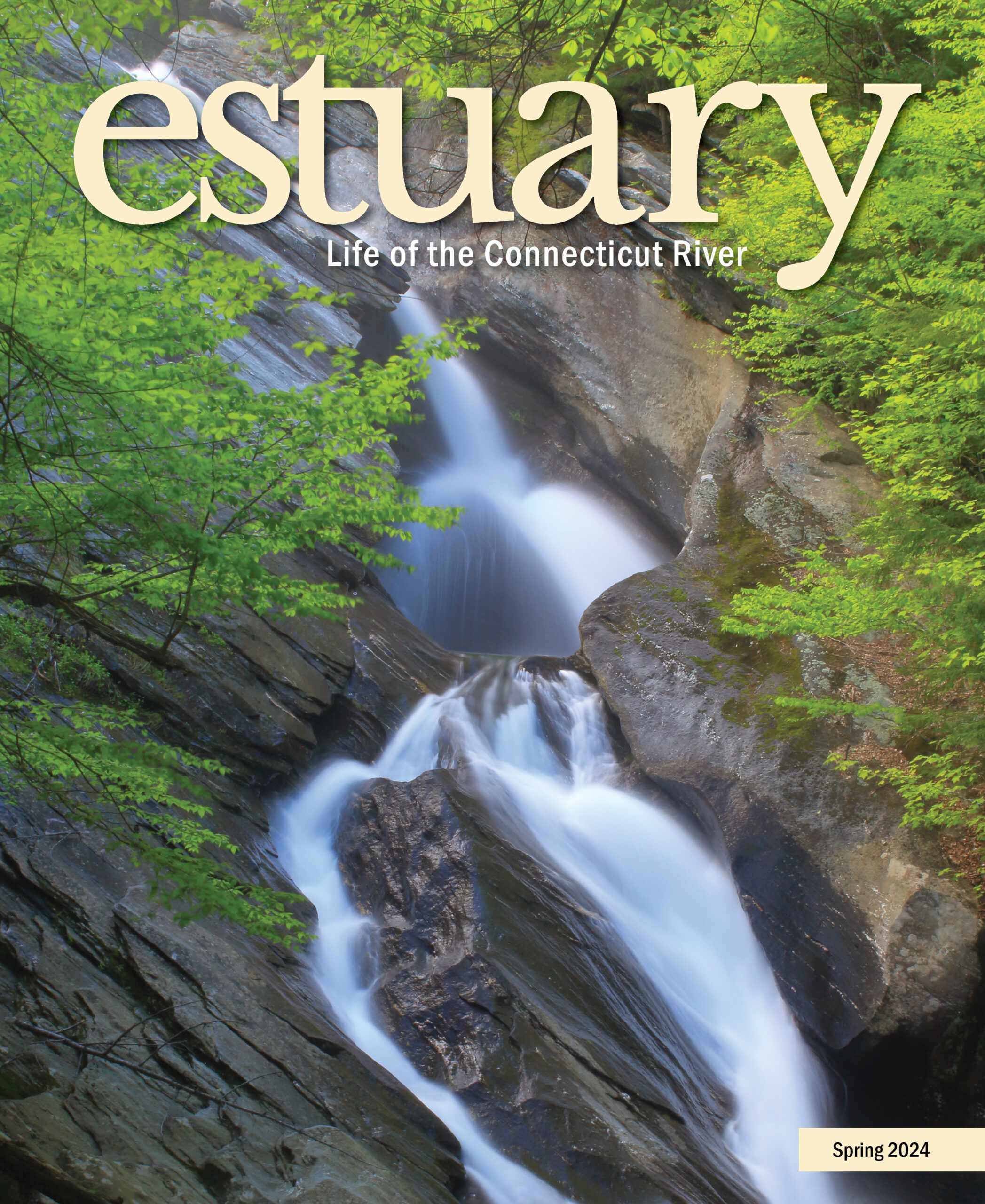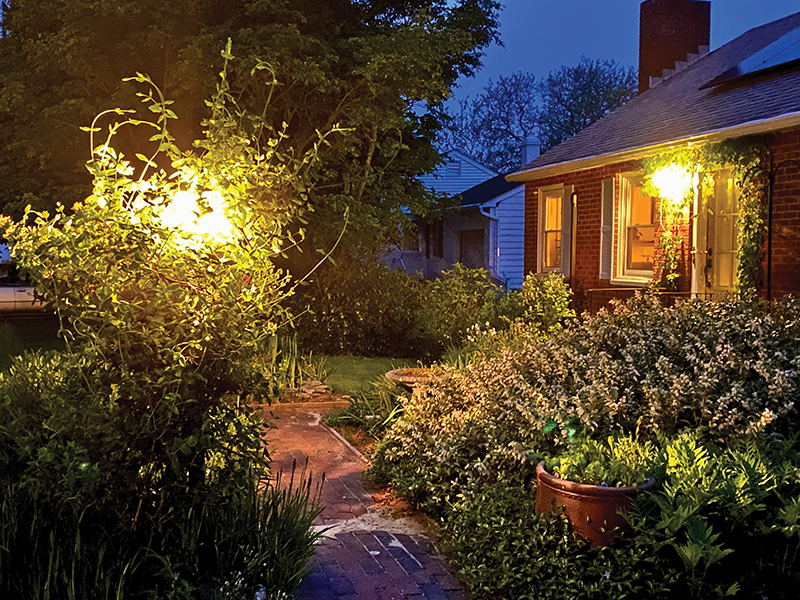 This article appears in the Spring 2024 issue
This article appears in the Spring 2024 issue

The Dark Side of Light
Why a Moonlit Garden is the Better Choice
The first twinkle of a June firefly is one of the greatest delights I experience from my yard. Long after I’ve pulled my garden gloves off and leaned the wheelbarrow against the shed, I return to marvel at a constellation of lights weaving among the plants. That experience harkens back to my childhood, but its future opportunity to engage and delight children of all ages is not guaranteed.
If you are wondering how fireflies can provide a segue into “Gardening for Good,” it’s because the diminutive flickers of this insect, as well as the nocturnal lifestyles of other organisms that we would like to share our backyard with, are not assured. Even the plants that define our gardens are not immune to this growing threat. The culprit? Outdoor lighting.

When outdoor lights are not covered and using downward facing bulbs, the result is light scatter and glare that can disrupt the activities of both plants and animals.
Most of the world’s human and animal populations have evolved with the predictable rhythm of day and night, with the sole orbit of the moon to highlight the night sky. That changed after the mid-1800s with the availability of electric outdoor lighting.
Today it’s estimated that at least 50 percent of the habitable land surface of the Earth experiences artificially bright night skies. This phenomenon, collectively called light pollution, has been officially defined using the acronym ALAN: Artificial Light At Night, and includes glare (light that excessively illuminates areas or objects), light trespass (that reaches beyond an intended or needed area), and skyglow (the upwelling illumination of the night sky). In the case of skyglow in particular, who among us has not seen that eerie dome of light, especially on overcast nights, that reveals a town, a shopping mall, or even the local train station in the distance?
The US-based International Dark Sky Association, formed in 1988, estimates that half of all species on Earth start their daily activities at sundown. For nocturnal animals, the introduction of artificial light has been posited as the most drastic change that humans have wrought to their environment.
Artificial light can create barriers to animal movement, fragmenting habitat just like roads and fences. Predators use light to hunt, while prey use darkness for cover. Shorter periods of nighttime darkness can interfere with the time needed for small mammals, amphibians, and some bats to forage.
Fireflies are a charismatic representative from the insect world that can elicit a favorable response to conservation efforts. According to the International Union for Conservation of Nature (IUCN), one in three assessed North American fireflies may be at risk of extinction. Factors other than light pollution contribute to this, including the loss of the suitable habitat like leaves and rotting logs. But for fireflies the very thing that makes them so iconic—that glowing bioluminescence—is a courtship signal that allows the flying male to communicate with a potential mate on the ground. Their ability to survive from one year to the next relies on darkness. Artificial light can cause their signal to decrease or entirely disappear.
Artificial light has been implicated as a driver of overall insect declines, many of which have evolved to use ambient light for courtship, foraging, and navigation. This should raise our concern for far more enigmatic insect species, including those that pollinate our food and ensure our garden flowers. Artificial light can have a big impact on the life cycles of the millions of nocturnal insect species on Earth.
We’ve all seen how insects—especially moths—congregate at streetlights and in car headlights (and, perhaps more noteworthy, is the eerie decline of that phenomenon as we question where those former concentrations have gone). Those moths emerged from caterpillars that are a critical food source for birds when they are rearing their young.
Many of our songbirds migrate at night, navigating by the moon and stars. They rely on time-honored seasonal cues to calibrate their internal compass. Artificial light can disrupt the timing of their migration. This can put them at a competitive disadvantage for getting to their nesting sites, especially to take advantage of ideal foraging at the very time insects emerge and caterpillars become available.
Illuminated landscapes can cause migratory birds to wander off course, become disoriented, and collide with buildings, a phenomenon that claims the lives of as many as a billion birds annually in the US alone. This is both a daytime and nighttime problem in urban areas, where glass and reflective building materials, as well as nighttime illumination, confuses the birds.
If you’re still not sure why light pollution is an issue for your garden, research has shown that streetlights can impact the time of leaf bud (and emergence of insects for migrating birds) and leaf drop in some trees, and alter flowering and growth in ornamental garden plants.
The loss of pollination provided by insects that are active at night cannot be compensated for by daytime pollinators. This impacts both plant reproduction and the availability of seeds—the very things that make gardens into habitat.
There can be a positive light at the end of this tunnel. While there is no such thing as wildlife-friendly lighting, there are things that can and are being done to address light pollution. Your garden, as part of a collective network of neighborhood and community green spaces, can increasingly be valued for connecting both historically fragmented habitats and providing critical resources for pollinating insects and wildlife—including being free of light pollution.
Here are some key recommendations from the Dark Sky Association:
- Consider when and where outdoor lighting is necessary. Although gardens are increasingly an extension of our living space, light these spaces with great care. Turn lights out when they’re not in use, or use a sensor, timer, or motion detector to prevent “dusk to dawn” illumination.
- Direct light downward using appropriate shielded fixtures, and limit their height to prevent “light trespass” across property lines. A big contributor to the attraction of light sources for most animals is seeing the actual bulb that is acting like an artificial moon or sun.
- Fluorescent lights (that emit more blue light) are less desirable than incandescent bulbs (light on the red end of the spectrum) because of their greater effect on circadian rhythms, and therefore nocturnal behaviors. Multicolor LED lights can be adjusted for color tone as well as brightness, and newer LED microarray lamps have precisely focused beams that avoid the sideways and upward light scatter of conventional lighting.
In 2022 New York City became the largest US urban area to adopt a Lights Out policy to help protect migratory birds. It requires all city-owned and leased buildings to turn off outdoor lights between 11 p.m. and 6 a.m. during spring and fall migrations. This type of initiative has been adopted in over two dozen US cities, and in 2019 France adopted a national Light Pollution policy, considered among the most progressive in the world.
In 2019 in the state of Delaware, local homeowners and the power company agreed to install a dark-sky friendly shield on a single streetlamp located next to the beach dunes where a small population of an endangered firefly had previously been known to live but could no longer be found. The following summer the Fish and Wildlife Service biologist studying them once again observed their unique bioluminescent flashing. Even small changes can make a difference.
Unlike so many vexing environmental problems, once you turn the light out the source of the pollution is extinguished and impacted species can begin to return. The most effective way of solving the light pollution problem is always going to be turning off the lights, the second best is being thoughtful about the lighting that we really need.
Judy Preston is a local ecologist active in the Connecticut River Estuary.
